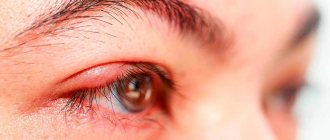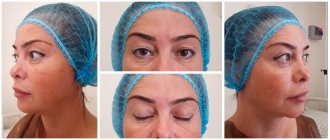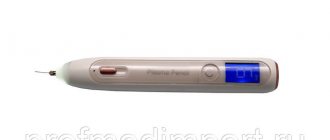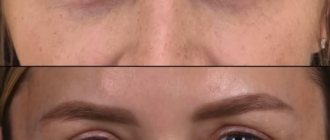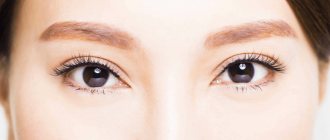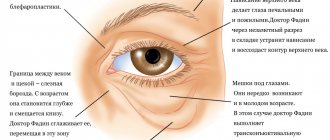Features of the structure of Asian eyes Contraindications Progress of the operation
Blepharoplasty is an operation during which the lower and upper eyelids are corrected in order to eliminate age-related, aesthetic defects, the consequences of injuries, fatty hernias, etc. One of the directions of this technique is the Europeanization of the upper eyelids, or an operation called “Singapuri”. Such an operation was first carried out at the end of the 18th century.
The oriental shape of the eyes is characteristic of many eastern peoples. Its signs:
- absence of a fold on the upper eyelid that forms when the eye is open (it may be present, but barely noticeable);
- the presence of a vertical fold (“Mongolian fold”) located in the inner corner of the eye, called the “epicanthus”;
- thicker eyelid skin than Europeans;
- a large amount of orbital fatty tissue, which forms a very smooth transition to the eyebrow from the upper eyelid and from the lower to the cheek.
This eye structure often interferes with everyday life, when building a career, and socialization. For a European, the face looks “heavy” due to the small size of the eyes and drooping upper eyelid. Therefore, people with oriental appearance decide on blepharoplasty, designed to Europeanize Asian eyelids.
The indication for intervention is the patient’s desire to correct his appearance.
Contraindications
- oncology;
- pregnancy and lactation;
- blood clotting disorder;
- cardiovascular diseases;
- general infections in the body;
- inflammatory processes in the intended intervention area;
- diabetes;
- chronic diseases in the acute stage;
- increased intraocular or blood pressure;
- thyroid diseases;
- dry eye syndrome
- blood diseases.
Memo for preparing for blepharoplasty: tests, prohibitions, recommendations
Preoperative examinations before blepharoplasty
Rehabilitation: Micro-needle RF lifting.
Fractional thermolifting is used for a wide variety of areas of the face and body, including the most delicate ones, carefully adjusting the depth and intensity of the treatment.
- Microneedles are used to deliver RF energy to the desired tissue level, but the procedure is bloodless.
- Innovative technologies help launch regeneration processes, activate blood flow, and restore lymphatic drainage.
- RF needle lifting goes well with various procedures.
The skin tightening effect is observed immediately after the end of the session.
Subsequently, with the launch of the production of new collagen and elastin, the lifting effect increases and becomes more pronounced. More about the procedure
The essence of the procedure
There are several surgical techniques; their choice is determined by the existing problem and the location of the tissue for which correction is necessary. Upper eyelid plastic surgery
This type of procedure is most common and consists of incision of the skin of the upper eyelid and resection of excess skin and fatty tissue; in parallel, muscle tissue plastic surgery can be performed. The incision is made in the area of the crease of the eyelid, so that subsequently the scar from it is almost invisible.
Transconjunctival blepharoplasty involves a slightly different approach - in this case, an incision is made in the area of the conjunctiva, the thin tissue that covers the inner surface of the eyelid.
This type of operation allows you to completely eliminate cosmetic defects after the intervention, since if a scar remains, it will only be on the inner surface of the eyelid. Lower eyelid surgery
The operation is aimed at removing bags and swelling, accumulation of excess fatty tissue under the eyes. Since the lower eyelid is in a tense state almost all the time, the scar on it is more visible - therefore, an incision is never made along the crease of the eyelid, but is formed along the ciliary edge of the eyelid.
For lower eyelid surgery, transconjunctival access can also be used, as is the case with upper blepharoplasty.
In fact, access through the conjunctiva was first used in lower eyelid surgery - this happened in the late 1990s at the University of Chicago Medicine. Since then, this technique has become the gold standard for lower blepharoplasty, it allows you to effectively remove excess fatty tissue and does not leave visible scars. The disadvantage of this technique is the inability to remove excess skin tissue. Circular blepharoplasty
The intervention is a combination of upper and lower blepharoplasty and can be performed using either traditional incisions or transconjunctival access, depending on the individual characteristics of the patient and the type of tissue that needs to be removed.
East Asian plastic surgery
This type of intervention is in demand among residents of the East Asian region and allows for modification of the eye shape.
The purpose of the operation is to lift the upper eyelid and form its crease, while simultaneously reducing the size of the lower eyelid (if necessary). In some Asian peoples, the natural anatomy of the eyelids is such that neither the upper nor the lower eyelid has a crease and looks approximately the same. After correction, the upper eyelid rises higher to the brow ridge and receives a fold characteristic of European anatomy. Laser plastic surgery
Often, laser eyelid plastic surgery is isolated as a separate type of plastic surgery, although upper, lower, circular, and East Asian plastic surgery can be performed using a laser scalpel.
The use of a laser makes it possible to simultaneously rejuvenate the skin of the eyelids and minimize intraoperative risks such as infection of the surgical wound. In addition, tissues heal somewhat faster after laser correction. After the procedure
After completion of the blepharoplasty procedure, canthopexy is usually performed - a small suture is placed on the outer part of the lower eyelid, which helps fix the position of the eyelid and thus speeds up the healing process. It uses self-absorbing suture material, so the stitch disappears after four to six weeks.
In a typical case, the operation, regardless of the type and technique of execution, lasts about two hours. The first time after the intervention there is swelling and hematomas in the eye area, which disappear after about two weeks. After another one or two months, the final cosmetic effect becomes visible.
Complications after plastic surgery are rare and are usually represented by dry eye syndrome, which resolves over time and can be successfully treated with the use of artificial tears.
Reviews about blepharoplasty in Korea, which foreign tourists leave on various forums and on their pages on social networks, indicate the high level of training of South Korean specialists. Many Korean doctors have specialized both in clinics in their native country and in large European and American plastic surgery centers and have all the necessary skills. Operations are carried out using modern equipment, including laser.
Operation procedure
The operation lasts from 1 to 3 hours, depending on the task. General anesthesia is used, rarely local anesthesia together with general sedation.
The operation can be performed with or without an incision. The optimal technique is selected by the surgeon, taking into account the individual characteristics of the patient. The second option is suitable for thin skin and mild drooping of the eyelids. It involves the application of hidden seams to form a fold characteristic of Europeans. An operation with an incision is more complicated, but the surgeon’s ability to remove the epicanthus and form a double eyelid is wider. First, the surgeon makes an incision that goes from the inner corner of the eye along the lash line on the upper eyelid. Excess fat and skin are excised. Then cosmetic stitches are applied. As a result, a double fold is formed on the upper eyelid. If self-absorbable suture material was not used, the sutures are removed after 5-7 days. There are no scars left.
The exact price for blepharoplasty to correct Asian eyes is determined by the surgeon after examining the patient. Call us to schedule a consultation.
The main task of the surgeon is to make a fold of the upper eyelid, and also, if necessary, remove the epicanthus, opening the inner corner of the eye. As a result, the gaze “opens”, and the distance between the eyes visually becomes larger.
Blepharoplasty in Korea
Blepharoplasty is an operation to change the shape of the eyelids and the shape of the eyes. A very popular operation, especially among the female population. With blepharoplasty in Korea
You can remove bags under the eyes, dark circles and tighten your skin. This type of surgery involves excision of excess skin and fatty formations.
Indications for eyelid surgery
- Overhang of the skin of the upper eyelid on the area of the upper eyelashes
- No upper eyelid crease
- Deep or numerous fine wrinkles in the lower eyelids
- Impaired vision due to drooping upper eyelid
- Bags under the eyes
- Excess skin of the lower eyelids
- Changing the shape and shape of the eyes
Types of blepharoplasty
1) Correction of the upper eyelid eliminates sagging
2) Correction of the lower eyelids helps get rid of bags under the eyes, swelling and hernias
3) Circular blepharoplasty
4) Correction of Asian eye shape (creating a double eyelid)
5) Changing the angles of the eyes (canthopexy)
6) Transconjunctival blepharoplasty – removal of fat deposits.
Upper eyelid blepharoplasty
With this intervention, excess skin, fat and muscle tissue are eliminated. The operation is performed under local anesthesia, but in some cases, at the request of the patient, general anesthesia is used. The procedure takes 60-90 minutes. During upper eyelid correction, the surgeon makes an incision in the natural crease, which avoids visible scars. Elimination of drooping eyelid folds can also be carried out using a laser, then no incisions are made, and the rehabilitation period is reduced to several days.
Due to the oriental structure of the eyes, blepharoplasty in Korea
very popular (changing the shape and shape of the eyes).
After manipulation, the skin becomes smooth, the look seems clear and open. This operation refreshes the face and erases visible signs of aging. With the correct actions of a specialist, the result will please you for more than 10 years.
After manipulation, the skin becomes smooth, the look seems clear and open. This operation refreshes the face and erases visible signs of aging.
The day after surgery, the patient must come to the clinic for examination. The sutures are removed on the 5th-6th day.
Lower eyelid blepharoplasty
Correction of the lower eyelid lasts 1-1.5 hours. The intervention is performed using general or local anesthesia. To perform the operation, the skin is incised along the eyelash line. The wound is sutured with intradermal sutures, resulting in a good aesthetic result.
In some cases, manipulation is performed through a transconjunctival incision (on the mucous membrane under the eyelid). In this way, small excess fat tissue can be removed. The method is used for unexpressed age-related changes. The resulting result improves your appearance for a long time and gives you a feeling of youth and attractiveness.
With the help of lower eyelid blepharoplasty, South Korean specialists achieve:
- eye contour correction;
- improving the properties of the skin under the eyes;
- changes in the shape and size of the eyelids;
- eliminating excess skin and fat;
- correction of hollows under the eyes.
Circular blepharoplasty
This is a simultaneous plastic surgery of the upper and lower eyelids. In one operation, you can get rid of several problems at once (wrinkles, sagging skin, fat bags). It is performed surgically, suturelessly or using a laser.
Recovery after blepharoplasty
Immediately after surgery, the eyes become swollen and bruised. To reduce these unwanted effects, after suturing your eyes, you will need to apply cold compresses and follow all the doctor's recommendations.
The day after eyelid surgery, the surgical wound is examined. The sutures are removed 5-7 days after the intervention.
After a recovery period of 5-6 weeks, the patient’s face looks completely natural, and postoperative stitches are not visible.
It is very difficult to choose a Plastic Surgery clinic among all the abundance. Ours offers you free assistance in choosing a clinic, organizing and preparing a trip to Korea.
Blepharoplasty in Korea is:
- assistance from highly qualified specialists;
- affordable prices;
- high level of service;
- short rehabilitation period;
- exactly the expected aesthetic result.
Approximate cost of plastic surgery procedures in Korea
| Type of operation | $ | being in Korea |
| Eyelid surgery (creating a double eyelid) | from 1,500 | 7 days |
| Blepharoplasty | from 2,000 | 7-10 days |

